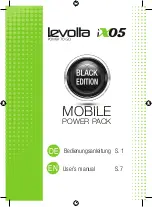
20
PCS100 UPS-I
User Manual
—
3
MODEL DEFINITION
3.1
Type Code
The PCS100 UPS-I type code is
given in the product tables. The
type code is a unique code for
the specific model PCS100 UPS-I
and
specifies
all
the
components that are used to
construct the model. From the
base code given in the product
tables options can be added to
the type code. These options
are called plus (+) codes.
The following diagram outlines
the structure of the type code:
PCS100-12
480/60
10
-
-
- R - EB05
FS2
+
PCS100 UPS-I
Rated Voltage & Rate Frequency
Number of Inverter modules
Termination Side (Front View)
Energy storage type & quantity
Options (plus codes)
Figure 3
-
1: PCS100 UPS
-
I type code
3.1.1
Rated Voltage
This is the rated maximum voltage of the PCS100 UPS-I. Options are 480V, 400V and 220V. Other operating
voltages (i.e. 380V) are achieved by software settings.
3.1.2
Rated Frequency
Options are 50 Hz and 60 Hz. 400 V models are only available at 50 Hz.
3.1.3
Number of Inverter Modules
The number of inverter modules needed depends on the load kVA. Each inverter module can deliver 150 kVA at the
rated voltage. Table 3-2 provides the allowable number of modules that can be employed.
Note: Operation at lower than the rated voltage results in less kVA per module. Consult the rating tables in the
UPS-I Technical Catalogue (document number 2UCD120000E002) for more information.
3.1.4
Termination Side
The location of the power terminals when viewed from the front of the PCS100 UPS-I. For 900 A and lower current
systems the termination is always on the Left (L). For > 900A systems the termination is always on the Right (R).
3.1.5
Energy Storage
Energy storage can be Ultracapacitors (EC) or Batteries (EB). The following number indicates the quantity of
strings of energy storage. For Ultracapacitors one string provides 300 kW of backup power. For batteries one
string provides 240 kW of backup power. The number of strings required depends on the load kW rating.
















































